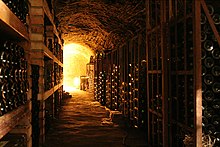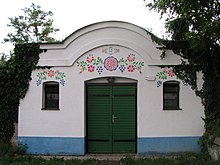Viticulture in the Czech Republic


Wine-growing region Bohemia
The Czech viticulture can look back on a thousand-year tradition. Around 45% of wine consumption in the Czech Republic is covered by domestic production, and the trend is rising. Shortly before joining the EU in 2004 , new vineyards with a total area of over 1,000 hectares were created. Around 18,750 hectares were cultivated in mid-2004.
history

At the beginning of the rule of the Přemyslids , a single vineyard dedicated to St. Wenceslas called Svatováclavská vinice , which is considered the oldest in Bohemia and was cultivated until 1877, was laid on the Cecemina near Dřísy . Before the Thirty Years' War , there are estimated to have been 10,000 hectares in Bohemia and 20,000 hectares in Moravia. The time between the 14th and 16th centuries is considered to be the golden age of viticulture. Emperor Charles IV was a great lover of wine and during this time he did a great job of growing wine in Prague . For example, the winegrowers were given acreage for cultivating vines or Karl exempted them from taxes. To protect the winemakers, the importation of foreign wines was prohibited.
A wine market is said to have been held for the first time in Valtice (Feldsberg in German) before 1850 , making it the oldest wine exhibition in the Czech Republic and Lower Austria. The more recent documented history of the exhibition began in 1967. There is an important wine cellar in the Valtice Castle vaults . There, newly awarded wines (“Salon” seal) are offered for tasting and purchase every year .
At the time of the division of Czechoslovakia in 1993 about 47,000 hectares of vineyards were planted, of which 36,000 hectares were in yield. The greater part of the planted vineyard area is now in Slovakia . The wine-growing areas of both countries border on the Bohemian areas on wine-growing areas in Austria and Hungary , as far as Tokaj-Hegyalja .

In 1995 a new wine law was created. This defines viticulture, production and the various types of wine. Due to the sugar content, the wines are classified into table wines, quality wines and wines with a predicate designation. The latter are in turn divided into Kabinettweine, Spätlese and Auslese. The legal framework for the Czech viticulture has been the European Union Wine Act since May 1st, 2004. However, the latest reform proposals from the EU are rejected by the Czech Ministry of Agriculture.
In 2002 the Czech Viticulture Center ( Národní vinařské centrum ) was founded in Valtice . This is a non-profit organization, in the creation of which some associations that are active in the field of wine production and tourism participated.
climate

The area of the largest wine-growing region in South Moravia has a subcontinental climate with typically warm to hot summers and relatively cold winters. The average seasonal temperature fluctuations are around 25 degrees Celsius. The amount of precipitation is rather low and averages around 500 mm.
The small wine-growing regions in the west of the Czech Republic are somewhat more moderate, but also shielded from the influence of the Atlantic climate by the Bohemian Basin (Czech: Česká kotlina ) .
Regions
Moravia

South Moravia is the country's most important wine region. Viticulture is concentrated around the river Thaya , a tributary of the March , and the area around the cities of Velké Pavlovice , Mikulov , Znojmo Hustopeče and Šatov which together with the Slovácko region represent 94% of the Czech vineyards. The most important are white wines, especially the Grüner Veltliner , which is also known in neighboring Lower Austria . Müller-Thurgau , Welschriesling and Chardonnay are also grown , the latter with a strong upward trend.
See also: Lists of cellar streets in the Mikulov , Slovácko , Velké Pavlovice and Znojmo wine regions
Bohemia
The spatially separated cultivation areas lie along the Elbe and its tributaries Vltava and Berounka , near Litoměřice ( Leitmeritz ), Mělník and Karlštejn . Individual vineyards are also on the western flank of the Bohemian Central Uplands near Most ( Brüx ) in the North Bohemian Basin.
Before the Thirty Years' War, Litoměřice was the largest wine-growing community in Bohemia after Prague. The consequences of the war and phylloxera led to a widespread decline. In the 20th century, the Bohemian viticulture was reactivated, which today makes up 5% of the total vineyard area in the Czech Republic. The Blend is here Müller-Thurgau , Pinot Blanc (Czech: Rulandské bílé ) and Gewurztraminer (Czech: Tramín červený ) and Riesling (Czech: Veltínské zelene ) as well as Pinot Gris , Riesling and red to a small extent varieties ( Blue Portugal ).
Historical parallels existed in the Middle Ages with the Saxon wine-growing region near Dresden and Meißen . Due to the geographical interruption of the Elbe wine-growing areas by Saxon Switzerland and the different histories of the regions after the Thirty Years War, there is no continuity with the Saxon Wine Route today .
Grape variety mirror
The most widespread grape varieties in the Czech Republic under Czech and German names with an indication of the percentage:
Red wine varieties (červené)
- Svatovavřinecké - St. Laurent , 9%
- Frankovka - Blaufränkisch , 5.6%
- Zweigeltrebe - Zweigelt , 4.7%
- Rulandské modré - Pinot Noir , 4%
- Modrý Portugal - Blue Portuguese , 3.9%
- Cabernet Sauvignon , 1.3%
In addition, the varieties Agni , Alibernet , André , Ariana , Cabernet Moravia , Jakubské ( early Burgundy ) and Neronet are grown in commercial viticulture .
White wine varieties (bílé)
- Müller-Thurgau , 11.2%
- Veltlínské zelené - Grüner Veltliner , 11%
- Ryzlink vlašský - Welschriesling , 8.5%
- Ryzlink rýnský - Riesling , 7%
- Sauvignon Blanc , 5%
- Rulandské bílé - Pinot Blanc , 5%
- Chardonnay , 4%
- Rulandské šedé - Pinot Gris , 3.7%
- Tramín červený - Gewürztraminer , 3%
- Neuburské - Neuburger , 2.3%
- Muškát moravský - Moravian nutmeg , 1.8%
- Veltlínské červené rané - early red Veltliner , 1.7%
- Oliver Irsay , 0.4%
Play a minor role, the varieties Aurelius , Bouvierův hrozen ( Bouvier ), Čabaňská Perla ( Pearl of Csaba ) Červenošpičák ( Rotgipfler ), Devin , Kerner , Lena , Malverina , Modrý Janek ( Blue Hans ) Muškát Ottonel ( Muscat Ottonel ), Pálava , Sylvánské červené ( Roter Silvaner ), Sylvánské zelené ( Silvaner ) and Veltlínské červenobílé ( Roter Veltliner )
Source: List of classifications of grape varieties for wine production according to Article 20 of Regulation (EC) 1227/2000, as of November 2007
Labeling
Indications of origin
- vinařská oblast - region, e.g. B. Morava (Moravia)
- vinařská podoblast - sub-region z. B. Velkopavlovická (Velké Pavlovice)
- vinařská obec - place name
- trať - indication of position
- Logo: wines from Bohemia, wines from Moravia. (since 2006)
Quality information
- révové víno - grape wine (to distinguish it from other wines; not mandatory)
- stolní víno - table wine
-
jakostní víno - at least 15 degrees Brix
- jakostní víno odrůdové - contains a maximum of three approved grape varieties
- jakostní víno známkové - Cuvée made from at least two approved grape varieties
- jakostní víno s přívlastkem - quality wine made from a maximum of three approved grape varieties (optional information on the label for proportions of at least 15%). Minimum must weight of 19 degrees Brix fermentable sugar - no chaptalization allowed. The maximum yield is limited to 12 tons / hectare. The wine must meet the quality criteria and be classified by the SZPI, the Czech organization for food control.
Residual sugar content
Basically, you have to choose between suché - dry and sladké - sweet as a flavor.
Trivia
In Hustopeče there is probably the world's only monument to the wine yeast ( Saccharomyces cerevisiae ). A sprouting yeast cell is shown enlarged 70,000 times.
swell
- Wine production in the Czech Republic - report from Radio Prague
- Don't drink wine in the Czech Republic! Report from Radio Prague
literature
- Helena Baker: Kapesní průvodce po vinařstvích a vínech České republiky 2007; ISBN 80-7350-071-X
Web links
Individual evidence
- ↑ a b Viticulture in the Czech Republic after joining the EU
- ↑ Hugh Johnson: The Little Johnson . Hallwag, Munich 2000 ( ISBN 3-444-70202-7 ).
- ^ Prague vineyards
- ^ Valtice wine market
- ↑ Czech Republic rejects EU wine reform ( page no longer available , search in web archives ) Info: The link was automatically marked as defective. Please check the link according to the instructions and then remove this notice.
- ^ Salon of Wines of the Czech Republic
- ^ "Definition of climatic zones" Subcontinental: III / 4
- ↑ Climate table of Brno in South Moravia
- ^ Historical wine cellar in Velke Pavlovice
- ↑ Znojmo: Unmistakable wines from historic vineyards
- ↑ Red, white, rosé
- ↑ List of classifications of grape varieties for winemaking (PDF; 514 kB) ( Memento from February 26, 2007 in the Internet Archive )
- ↑ Quality brand for wines from the Czech Republic
- ^ State Agricultural and Food Inspection SZPI ( Memento from June 7, 2007 in the Internet Archive )
- ↑ The Czech Wine
- ↑ High appreciation: Wine yeast carved in stone


